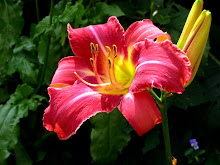
End-of-season cleanup of perennial beds often seems like a chore, and there have been years where I just left it all (a la Ruth Stout) and figured I’d clean up in the spring (or not). No harm done, it seemed, except that all that vegetation is just so much more slimy and difficult to clean up after winter is over, and I’m afraid of stomping on the emerging new growth.
So nowadays, a few of the garden perennials are left for winter texture and for their seed heads that will attract the birds; but daylilies, in particular, seem to benefit from tidying up in the fall.
Always with an eye for other gardens, I’ve noticed that some gardeners cut their daylily foliage back right after the end of bloom. Most of the “experts” discourage that; as long as the foliage is green, the plant is still synthesizing and feeding the roots. In fact, cut the foliage TOO early, and the plant will send up new shoots – using up energy better saved for next year. But once the foliage yellows and browns, it can be removed.
So the photo at the top of the post is an example of a daylily that’s going into dormancy; the foliage is yellow and limp. Just take a pair of shears and cut the leaves several inches above the ground, and toss the leaves onto your compost pile.

It’s a great opportunity to remove weeds as well (because we got tired of weeding about two months ago, right?), and no doubt you’ll be surprised at how much some clumps have increased. And it's a good time to make a list of what will need dividing in the spring. AND to throw some compost into the beds, if you’re so inclined. Cleaning up the foliage makes that easier as well.



